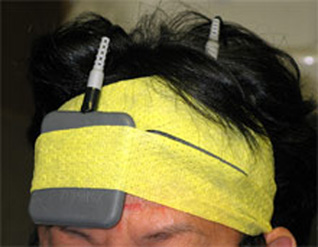DIY Kit Overclocks Your Brain With Direct Current
It turns out that one of the ways you can speed up a microprocessor – shoving more current into it – also works on the human brain. The technique is called transcranial direct current stimulation, and while bioethicists are debating whether or not it’s ethical to use it to enhance learning in children, hobbyists have figured out how to try it out at home. Think of it as the new Adderall – without, apparently, the side effects.

Now, the first thing I have to say in this post about how to overclock your brain with a straightforward 20-minute application of electrical current is DO NOT TRY THIS AT HOME. The long-term effects of TDCS are unknown, and if you mess up and put orders of magnitude more current through your brain than is typically used in TDCS, obviously, you could kill yourself.
Now that we have that out of the way, here’s how to try it at home.
GoFlow is a startup planning to offer TDCS kits for as little as $99.
Today if you want to buy a tDCS machine it’s nearly impossible to find one for less than $600, and you are typically required to have a prescription to order one. We wanted a simpler cheaper option. So we made one.
GoFlow claims that their product can help speed up learning – an effect that’s already been demonstrated by the Air Force and in the lab.
Air Force researchers were delighted recently to learn that they could cut [the time required to train drone pilots] in half by delivering a mild electrical current (two milliamperes of direct current for 30 minutes) to pilot’s brains during training sessions on video simulators. There is also evidence that TDCS can induce the state of creative nirvana known as “flow.”
When done correctly by a licensed physician, TDCS is safe enough that it’s already being used clinically to treat chronic pain. The GoFlow, on the other hand, appears to have been built by undergraduates. Given the (lack of) production values in their promotional video, I’m not all that reassured by the included testimonial from a neuroscience graduate student.
If you can’t wait for the GoFlow kids to get their act together, the Journal of Visual Experiments has an elaborate video tutorial demonstrating the finer points of TDCS administration.
Keep Reading
Most Popular
Large language models can do jaw-dropping things. But nobody knows exactly why.
And that's a problem. Figuring it out is one of the biggest scientific puzzles of our time and a crucial step towards controlling more powerful future models.
The problem with plug-in hybrids? Their drivers.
Plug-in hybrids are often sold as a transition to EVs, but new data from Europe shows we’re still underestimating the emissions they produce.
Google DeepMind’s new generative model makes Super Mario–like games from scratch
Genie learns how to control games by watching hours and hours of video. It could help train next-gen robots too.
How scientists traced a mysterious covid case back to six toilets
When wastewater surveillance turns into a hunt for a single infected individual, the ethics get tricky.
Stay connected
Get the latest updates from
MIT Technology Review
Discover special offers, top stories, upcoming events, and more.